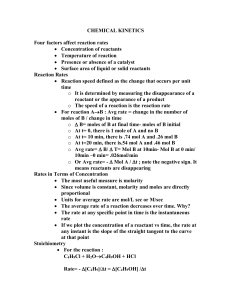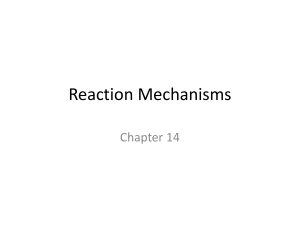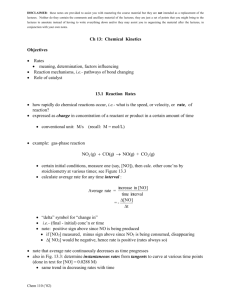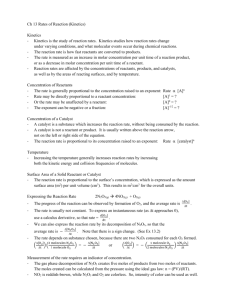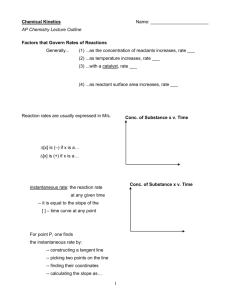CHAPTER 14. CHEMICAL KINETICS
advertisement
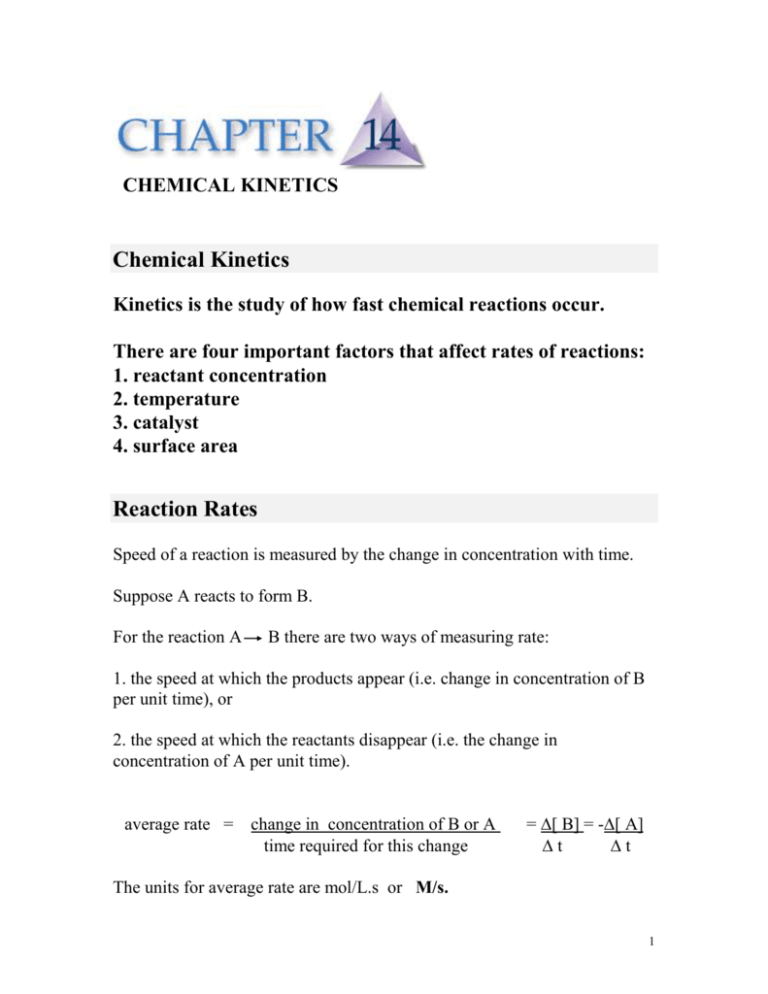
CHEMICAL KINETICS Chemical Kinetics Kinetics is the study of how fast chemical reactions occur. There are four important factors that affect rates of reactions: 1. reactant concentration 2. temperature 3. catalyst 4. surface area Reaction Rates Speed of a reaction is measured by the change in concentration with time. Suppose A reacts to form B. For the reaction A B there are two ways of measuring rate: 1. the speed at which the products appear (i.e. change in concentration of B per unit time), or 2. the speed at which the reactants disappear (i.e. the change in concentration of A per unit time). average rate = change in concentration of B or A time required for this change = [ B] = -[ A] t t The units for average rate are mol/L.s or M/s. 1 The rate at any instant (instantaneous rate) is the slope of the tangent to the curve ( r =-d[A]/dt Instantaneous rate is different from average rate. We usually call the instantaneous rate the rate Reaction Rates and Stoichiometry In general for aA + bB cC rate = - 1 d[A] = - 1 d[B] = a dt b dt + dD 1 d[C] = 1 d[D] c dt d dt Dependence of Rates on Concentration In general, rates increase as concentrations increase. For the reaction: NH4+(aq) + NO2-(aq) N2(g) + 2H2O(l) we note : as [NH4+] doubles with [NO2-] constant, the rate doubles, as [NO2-] doubles with [NH4+] constant, the rate doubles. We conclude rate [NH4+] [NO2-] Rate law: Rate = k[NH4+] [NO2-] The constant k is the rate constant 2 Note that the rate constant k does not depend on concentration. For a general reaction with rate law: Rate = k[reactant 1]m[reactant 2]n we say the reaction is mth order in reactant 1 and nth order in reactant 2. The overall order of reaction is m + n A reaction can be zeroth order if m, n are equal to zero. Note the values of the exponents (orders) have to be determined experimentally. They are not simply related to stoichiometry. The Change in Concentration with Time First-Order Reactions Goal: convert rate law into a convenient equation to give concentrations as a function of time. Consider the hypothetical reaction: A B For a first order reaction, the rate doubles as the concentration of a reactant doubles. Therefore: rate = - d[A] = k[A] dt 1n[A]t - 1n[A]0 = - kt. Rearranging: 1n[A]t = - kt + 1n [A]0 A plot of 1n[A]t versus t is a straight line with slope -k and intercept ln[A]0 3 Half-life Half life is the time taken for the concentration of a reactant to drop to half its original value. That is, half life, t1/2 is the time taken for [A]0 to reach 1/2[A]0 Mathematically: So for t = t1/2 ln [A]t = - kt [A]0 and [A]t = 1/2[A]0, 1n 1/2[A]0 = - kt1/2. [A]0 1n 1/2 = - kt1/2. Therefore: t1/2 = - 1n 1/2 k = 0.693 . k Second-Order Reactions For a second order reaction, Consider the hypothetical reaction: A B Rate = - d[A] = k[A]2 . dt Integrating gives 1 [A]t = kt + 1 . [A]0 A plot of 1/[A]t versus t is a straight line with slope k and intercept 1/[A]0 For a second order reaction, a plot of 1n[A]t vs. t is not linear. We can show that the half life is: t1/2 = 1 k[A]0 4 Temperature and Rate Most reactions speed up as temperature increases. (e.g. food spoils when not refrigerated.) As temperature increases, the rate increases. Since the rate law has no temperature term in it, the rate constant must depend on temperature. The Collision Model Goal: develop a model which explains why rates of reactions increases as concentration and temperature increase. The collision model: in order for molecules to react they must come into direct contact via collosion and must possess a minimum kinetic energy to react The greater the number of collisions the faster the rate. Complication: not all collisions lead to products. In fact, only a small fraction of collisions lead to product. Activation Energy Arrhenius: molecules must posses a minimum amount of energy to react. 5 Activation energy, Ea, is the minimum energy required to initiate a chemical reaction . In order to form products, bonds must be broken in the reactants. Bond breakage requires energy 6 Example: Consider the rearrangement reaction of the conversion of methyl isonitrile CH3NC to methyl acetonitrile CH3CN. As the temperature increases the bond bends until the C-N bond breaks and the NC portion is perpendicular to the H3C portion. H3C N C H3C C N H3C C N This structure is called the activated complex or transition state. The energy required for the above twist and break is the activation energy, Ea. Once the C-N bond is broken, the NC portion can continue to rotate forming a C-C N bond. The change in energy for the reaction is the difference in energy between CH3N C and CH3C N. 7 The activation energy is the difference in energy between reactants, CH3NC and transition state. In order for reaction to occur the reactant molecules must collide with enough energy in the correct orientation to form products. Consider the reaction between Cl and NOCl: If the Cl collides with the Cl of NOCl then the products are Cl2 and NO. If the Cl collided with the O of NOCl then no products are formed. We can qualitatively explain the various influence of concentration and temperature on the rate of reactions based on collosion model: Effect of Concentration: The more molecules present, the greater the probability of collisions and the faster the rate. 8 Effect of Temperature The higher the temperature, the more energy available to the molecules and the faster the rate. The Arrhenius Equation Arrhenius discovered most reaction-rate data obeyed the equation: k = Ae-Ea/RT k is the rate constant, Ea is the activation energy, R is the gas constant (8.314 J/K-mol) and T is the temperature in K A is called the frequency factor. A is a measure of the probability of a favorable collision. Both A and Ea are specific to a given reaction. Ea can be determinedand graphically : 1n k = - Ea + ln A RT Or Ea can be determined if the rates of chemical reactions are known for two given temperatures: 9 1n k1 = Ea 1 - 1 k2 R T2 T1 Reaction Mechanisms The reaction mechanism gives the path of the reaction ; or the process by which a chemical reaction occurs Mechanisms provide a very detailed picture of which bonds are broken and formed during the course of a reaction. Balanced chemical equation gives you only the substances at the start and the products. Elementary Steps Elementary step: any process which occurs in a single step. Molecularity: the number of molecules present in an elementary step, Unimolecular: one molecule in the elementary step O3(g) O2(g) + O(g) Bimolecular: NO2 (g) + CO(g) two molecules in the elementary step NO(g) + CO2(g) termolicular: three molecules in the elementary step It is not common to see termolecular processes . Elementary steps must add to give the balanced chemical equation. Intermediate: a species which appears in an elementary step which is not a reactant or product. 10 A chemical reaction often occurs in several elementary steps. For instance the following reaction occurs in two steps: NO2 (g) + CO(g) NO (g) + CO2(g) 1. NO2(g) + NO2(g) 2. NO3(g) + CO(g) NO3 + NO(g) NO2 + CO2 The overall reaction is the sum of the elementary steps: 2NO2 (g) + NO3 + CO(g) NO3 (g) + NO(g) + NO2(g) + CO2(g) Rate Laws of Elementary Steps The rate laws of the all elementary steps determine the overall rate law of the reaction. The rate law of an elementary step is determined by its molecularity: 1.imolecular processes are first order, 2. Bimolecular processes are second order, and 3. Termolecular processes are third order. Rate Laws of Multistep Mechanisms Rate-determining step: is the slowest of the elementary steps. Therefore, the rate-determining step governs the overall rate law for the reaction. For instance the following reaction occurs in two steps: NO2 (g) + CO(g) NO (g) + CO2(g) Step 1. NO2(g) + NO2(g) Step 2. NO3(g) + CO(g) k1 k2 NO3(g) + NO(g) (slow) NO2(g) + CO2 (g) (fast) 11 K2 >>>K1 , NO3 slowly produced in step 1 is immediately consumed in step 2 The rate determining steps is step 1 (slowest step): R= k1[NO2]2 the rate law predicted by this mechanism agrees with the one observed experimentally. Mechanisms with an Initial Fast Step It is possible for an intermediate to be a reactant. Consider: 2NO(g) + Br2(g) 2NOBr(g) The experimentally determined rate law is: Rate = k[NO]2[Br2] The termolecular mechanism is be ruled out since it is not probable Consider an other mechanism: k1 Step 1: NO(g) + Br2(g) NOBr2(g) (fast) k-1 k2 Step 2: NOBr2(g) + NO(g) 2NOBr(g) (slow) for which the rate law is (based on Step 2): Rate = k2 [NOBr2][NO]. The rate law should not depend on the concentration of an intermediate because intermediates are usually unstable. Assume NOBr2 is unstable, so we express the concentration of NOBr 2 in terms of NOBr and Br2 assuming there is an equilibrium in Step 1 we have by definition of equilibrium: k1[NO][Br2] = k-1[NOBr2] therefore: [NOBr2] = k1/k-1 [NO][Br2 Rate = k2 [NOBr2][NO] the overall rate law becomes: Rate = k2 k1/k-1 [NO][Br2][NO] = k[NO]2[Br2]. 12 Catalysis A catalyst changes the rate of a chemical reaction by lowering the activation energy Catalysts can operate by increasing the number of effective collisions. That is, from the Arrhenius equation: catalysts increase k by increasing A or decreasing Ea. k = Ae-Ea/RT 13 There are two types of catalyst: 1. homogeneous 2. heterogeneous. Homogeneous Catalysis The catalyst and reaction is in one phase. Example: Hydrogen peroxide decomposes very slowly: 2H2O2(aq) 2H2O(l) + O2(g). In the presence of the bromide ion, the decomposition occurs rapidly: 2Br-(aq) + H2O2(aq) + 2H+(aq) Br2(aq) + 2H2O(l) Br2(aq) is brown. Br2(aq) + H2O2(aq) 2Br-(aq) + 2H+(aq) + O2(g). Br- is a catalyst because it can be recovered at the end of the reaction. The mechanism pathway with catalyst is different from that without catalyst because the catalyst (Br-) added an intermediates (Br2(aq) ) to the reaction. 14 Heterogeneous Catalysis The catalyst exists in different phase from the reactants molecules Usually the catayst is a solid in contact with either gaseous reactans or with reactants in liquid solution. Most industrial catalysts are heterogeneous that occcur at the surface of the catalysts (the catalysts are usually metals or metal oxide) First step is adsorption (the binding of reactant molecules to the catalyst surface). Adsorbed species (atoms or ions) are very reactive. Molecules are adsorbed into active sites on the catalyst surface. Consider the hydrogenation of ethylene: C2H4(g) + H2(g) C2H6(g), H = -136 kJ/mol. The reaction is slow in the absence of a catalyst. In the presence of a metal catalyst (Ni, Pt or Pd) the reaction occurs quickly at room temperature. First the ethylene and hydrogen molecules are adsorbed into active sites on the metal surface. 15 The H-H bond breaks and the H atoms migrate about the metal surface. When an H atom collides with an ethylene molecule on the surface, the C-C bond breaks and a C-H bond forms. When C2H6 forms it desorbs from the surface. When ethylene and hydrogen are adsorbed into a surface, less energy is required to break the bonds and the activation energy for the reaction is lowered. Enzymes Enzymes are biological catalysts. Most enzymes are protein molecules with large molecular masses Enzymes have very specific shapes. Most enzymes catalyze very specific reactions. Substrates undergo reaction at the active site of an enzyme. A substrate locks into an enzyme and a fast reaction occurs. The products then move away from the enzyme. Only substrates which fit into the enzyme lock can be involved in the reaction. 16 If a molecule binds tightly to an enzyme so that another substrate cannot displace it, then the active site is blocked and the catalyst is inhibited (enzyme inhibitors). 17
